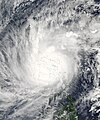ไฟล์:Durian 2006-11-30 0500Z.jpg

ขนาดของตัวอย่างนี้: 457 × 599 พิกเซล ความละเอียดอื่น: 183 × 240 พิกเซล | 366 × 480 พิกเซล | 586 × 768 พิกเซล | 781 × 1,024 พิกเซล | 1,563 × 2,048 พิกเซล | 5,800 × 7,600 พิกเซล
ดูภาพที่มีความละเอียดสูงกว่า (5,800 × 7,600 พิกเซล, ขนาดไฟล์: 6.18 เมกะไบต์, ชนิดไมม์: image/jpeg)
ประวัติไฟล์
คลิกวันที่/เวลาเพื่อดูไฟล์ที่ปรากฏในขณะนั้น
| วันที่/เวลา | รูปย่อ | ขนาด | ผู้ใช้ | ความเห็น | |
|---|---|---|---|---|---|
| ปัจจุบัน | 08:29, 11 ธันวาคม 2549 |  | 5,800 × 7,600 (6.18 เมกะไบต์) | Coredesat | |
| 08:25, 11 ธันวาคม 2549 |  | 5,000 × 6,500 (11.94 เมกะไบต์) | Coredesat | ||
| 08:11, 11 ธันวาคม 2549 |  | 5,000 × 6,000 (5.12 เมกะไบต์) | Coredesat | {{Information |Description=NASA MODIS image of Typhoon Durian over the Bicol Region of the Philippines, on November 30, 2006. |Source=[http://earthobservatory.nasa.gov/NaturalHazards/shownh.php3?img_id=13996 NASA Ea |
หน้าที่มีภาพนี้
หน้าต่อไปนี้ โยงมาที่ภาพนี้:
การใช้ไฟล์ข้ามโครงการ
วิกิอื่นต่อไปนี้ใช้ไฟล์นี้:
- การใช้บน de.wikipedia.org
- การใช้บน en.wikipedia.org
- การใช้บน fr.wikipedia.org
- การใช้บน nl.wikipedia.org
- การใช้บน sv.wikipedia.org
- การใช้บน tl.wikipedia.org


